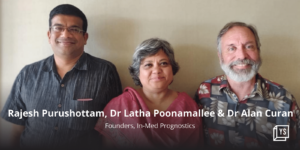Despite being the startup capital of India, Bengaluru continues to face challenges when it comes to intracity travel. Hiked cab fares owing to rising fuel prices, and the high demand of ride-hailing services coupled with the supply crunch has recently made it difficult for users to get a commute during the peak hours. Not to mention the infamous traffic.
Having said that, finding the right solutions to use public transportation has always been a challenge.
Bengaluru-headquartered Tummoc (palindrome for ‘commute’), a multi-modal transit patented public transport app, is helping users with real-time public transport (with buses and metros) information and first and last-mile connectivity. The startup was founded by Narayan Mishra, Hiranmay Mallick, and Monalisha Thakur in 2016.
In a conversation with YourStory, Co-founder and CEO Hiranmay Mallick says, “We strive to make public transport commutes seamless across the country, and eventually across the globe.”
At present, Tummoc is doing this solely for commoners to help them plan their end-to-end intra-city travel, while making the most of the available public transport infrastructure. The startup has collaborated with BMTC (Bangalore Metropolitan Transport Corporation) for facilitating bus ticketing services and has joined hands with bike-taxi aggregator Rapido to enable last-mile connectivity.
The evolution
Back in 2016, the co-founders started Bykerr–an operations-savvy company primarily focused on first and last-mile connectivity and ride booking. It allowed users to book bike and auto rides.
Between 2016 and 2019, the team was busy laying down the groundwork, creating an MVP, getting the first 1,000 users, and carrying out the alpha and beta testing. Bykerr went on to win the Best Startup of Karnataka award in 2018 and received a grant for Best Startup from the Government of Karnataka.
Later, the trio decided to change the name of the app to convey what they were doing. In January 2021, the team rebranded Bykerr to Tummoc. “We wanted to reverse the decline of public transportation use and the name thus aligned,” says Hiranmay.
Despite the pandemic and successive lockdowns, the platform managed to grow its user base to 50,000 by June. In August, the number doubled to one lakh users, and a month later, Tummoc got its first patent approved for ‘System and Method for multi-modal trip planning with first and last-mile connectivity.’
While the founders refused to share the details of the initial investment, Tummoc has raised $540,000 in seed capital and plans to raise Series A round of funding soon.
The founding team at Tummoc
How does it work?
Patents need to be broken down into components such as software, algorithms, systems, and hardware. The derivation of these components together makes the outcome that can be patented as a system.
For Tummoc, the system is patented in a way that it plans multimodal trips for users travelling from one point to another. The three sub-components involved in delivering this multi-modal plan includes–ride suggestion engine, feedback engine, and ride scoring algorithm.
The Home page of Tummoc app
So, when a first-time user searches for a plan for a location, the system checks the scoring algorithm in the backend. “We observe if there is any pattern or combination of modes that users prefer to take, and based on that history, the outcome is customised as per the need of every user or their choice of experience, and that will differ from user to user,” Hiranmay explains.
Under the ride suggestion engine, there is a subsystem available for first and last mile commute.
“This is the most important concept without which the planning of transit will become inefficient. There needs to be a simplified connection or availability of modes to reach public transport,” he says. Tummoc bridges the gap in public transportation by suggesting first and last mile commutes.
Once a user books a ride, they can tap on the particular leg of the ride. That is, when they take the first mile commute, they tap for the first time, and this goes on. Each leg of the journey is tracked when the user taps in and taps out for the payment. This helps the platform track buses and metros and derive the ETA (estimated time of arrival).
Finally, the ride scoring algorithm generates a score at the end of the ride, depending on the total time and cost of travel predicted versus what the actual time and cost were. This score is then used to generate future routes and suggestions.
The mobility business
With a population size so large, public transportation is almost indispensable when it comes to daily mobility in India. According to reports, about 18 percent of the total population, that is 36.5 million people in India, travel by public transport daily. In fact, 15 Indian cities have operational rapid transit or metro systems in them. Delhi, the second-most populous city in the country, has 229 million people commuting via metros on a regular basis.
“This market is worth $10 billion. While we do not have any direct competitors, we indirectly compete with the likes of Chalo, Moovit, and m-Indicator,” says Hiranmay.
Tummoc’s USP lies in the fact that it provides multi-modal public transportation information.
Going ahead, the startup is also working on a single ticketing model where users can book first, mid, and last mile commutes under a single ticket–a QR-code or an ID-based ticket.
“We will not only be able to predict the first and last mile commutes, and the availability of the bus or metro with the help of real-time tracking, but will also allow users to book an end-to-end journey from a single app,” Hiranmay states.
The founders claim that Tummoc is the country’s only patented multi-modal transit application. It has eight lakh users registered on its application, and the startup records 30 percent repeat users, with a month-on-month growth of between 20 to 30 percent.
While the app is free to use for now, the team is working on generating revenue once it enters the B2B segment (of allowing users to book intra-city tickets), and by running ads on its apps. At present, Tummoc has a team of 25-plus members and has been hiring on a regular basis to expand to other cities.
Going forward, Tummoc plans to add intra-city rail information for Bengaluru, Hyderabad, Kolkata, Mumbai, Delhi, Chennai, and Kochi, before expanding pan-India.
“We want to be the only B2B and B2C transit system provider in the industry,” Hiranmay ends.





![Read more about the article [Funding alert] EV startup BGAUSS raises $6.8M in Series A round](https://blog.digitalsevaa.com/wp-content/uploads/2022/04/ImagesFrames48-1651055210691-300x150.png)




